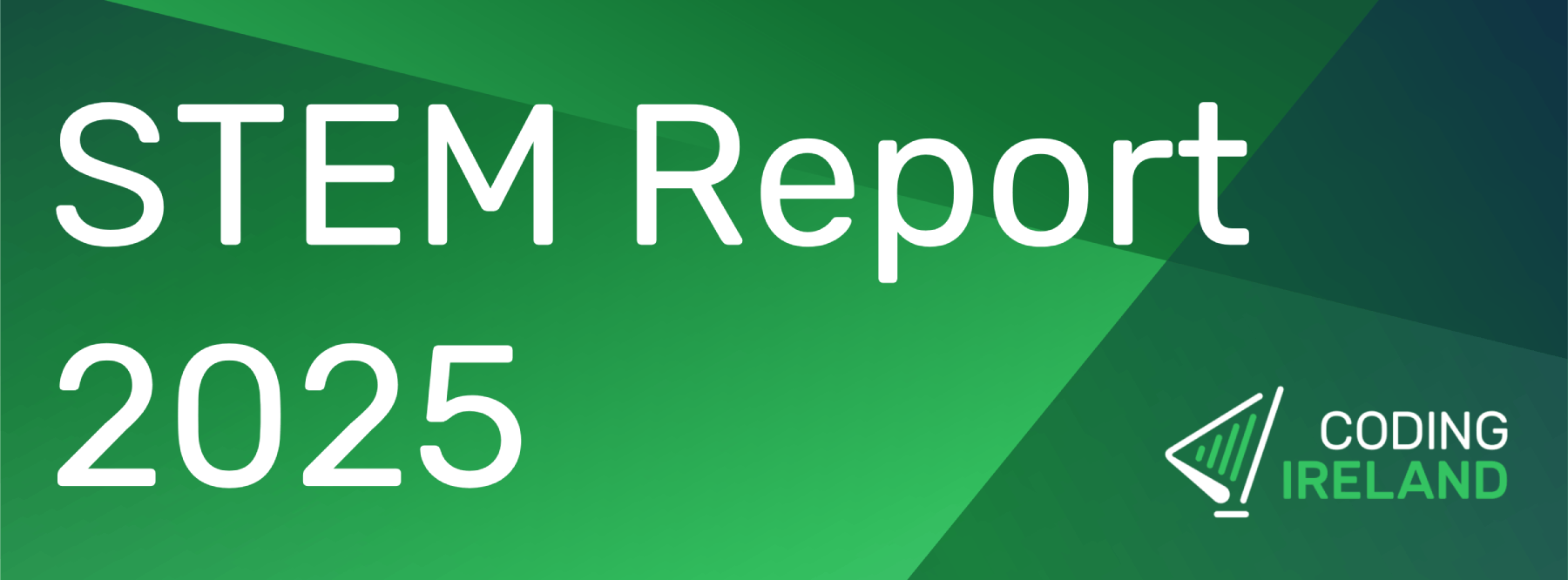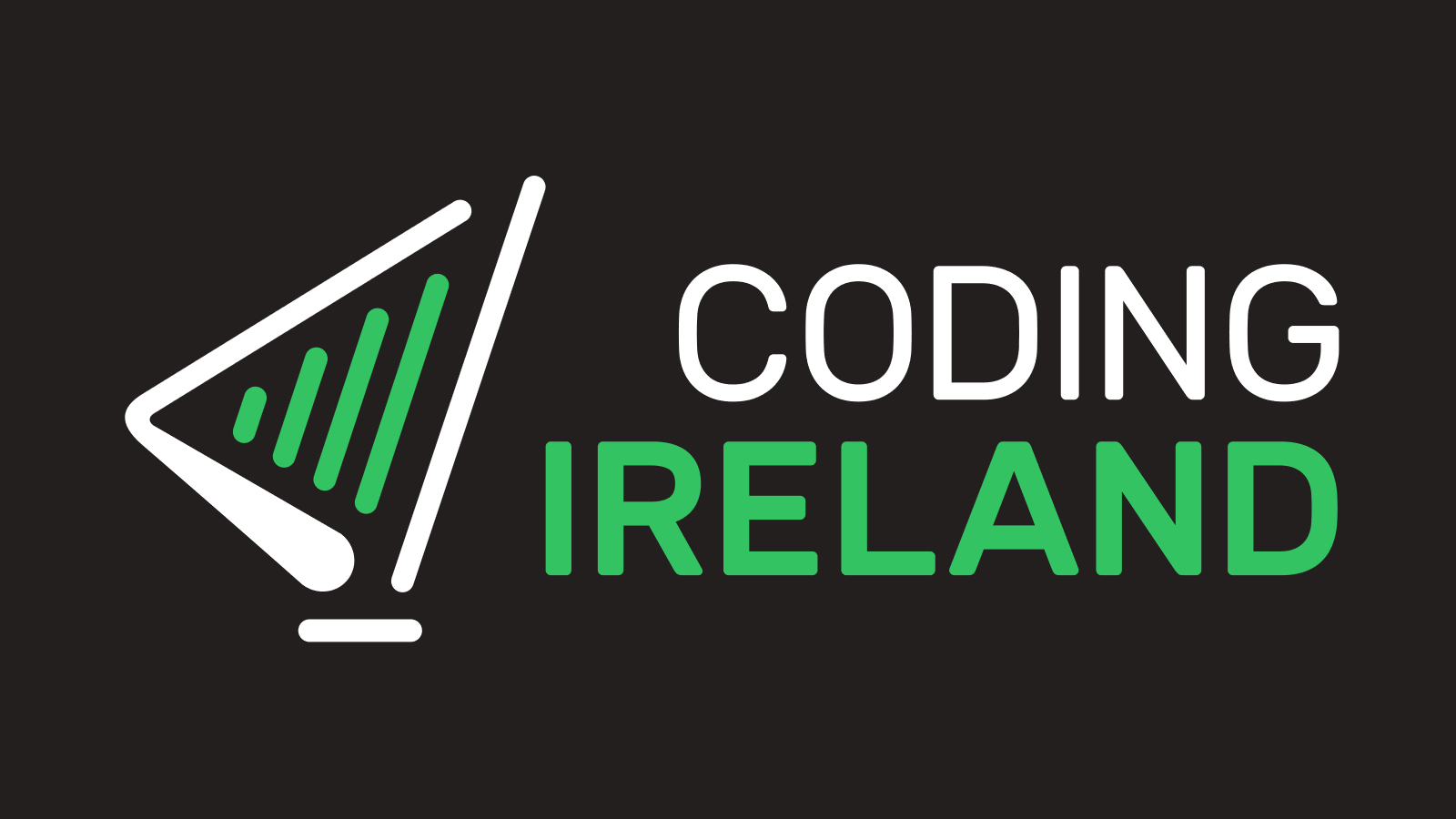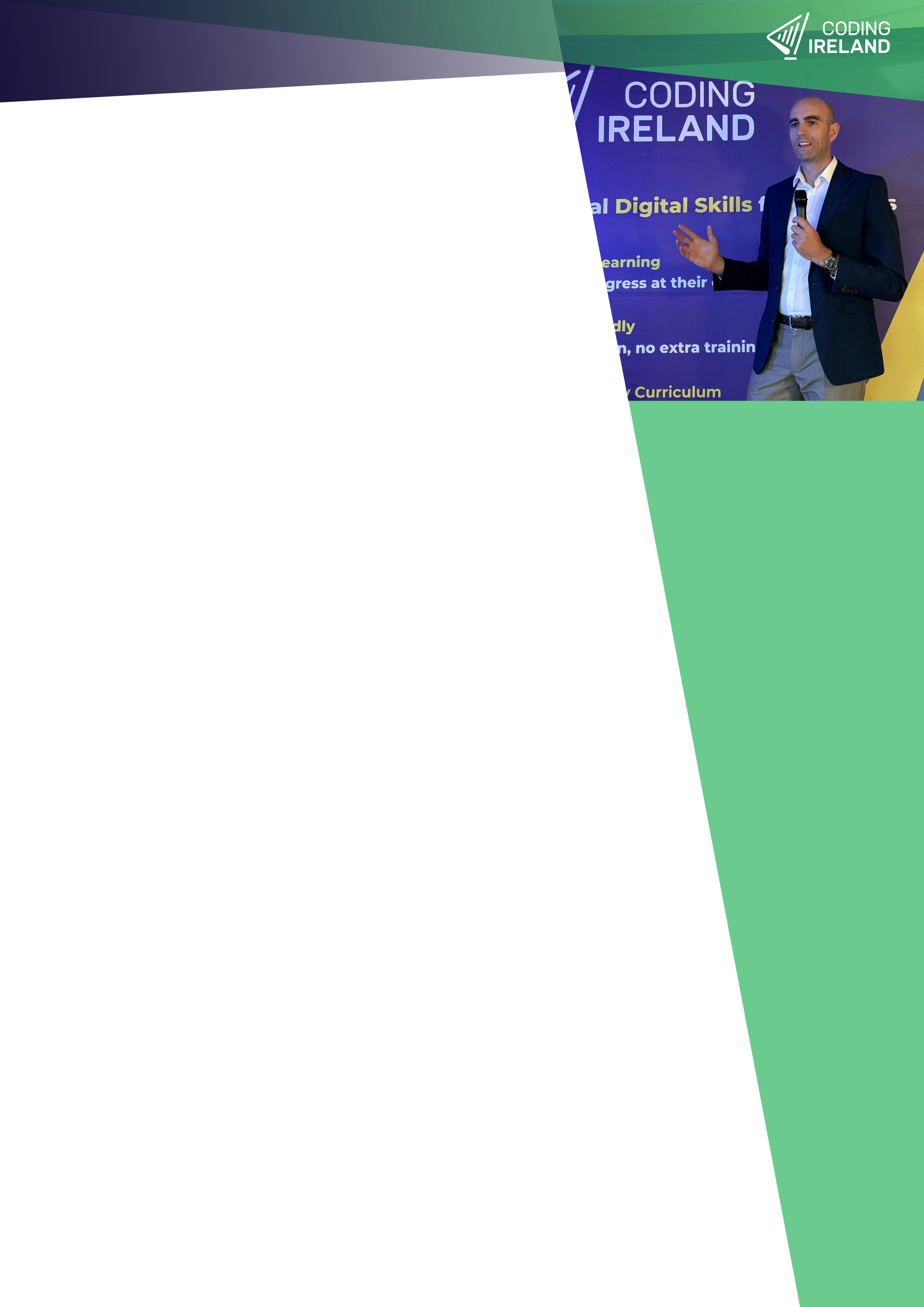
Foreword
We are delighted to present the Coding Ireland STEM Report 2025, offering the most comprehensive analysis of STEM education in Ireland. Building on the success of our inaugural 2024 report, this year’s edition saw unprecedented engagement, with over 1,000 schools, libraries, and youth training centres participating, our highest turnout to date. With two years of data, we can now identify trends in STEM education across Ireland, from educator perspectives to resource availability, professional development, funding, infrastructure, and future directions.
My heartfelt thanks go to the educators, policymakers, and STEM advocates who shared their invaluable insights for this report. Your expertise and dedication to educating Ireland’s youth truly makes a difference, and your collaboration has been essential to this report.
STEM education is essential for Ireland’s future, cultivating critical thinking, problem-solving, creativity, and resilience; key skills our youth need to excel in a rapidly changing world. This report underscores the importance of these efforts to strengthen STEM learning nationwide.
I urge everyone in Ireland’s educational community to engage with its findings and join us in shaping a brighter future for our youth through STEM education. Together, we can empower the next generation of innovators and problem-solvers.
Alan Joyce
Founder, Coding Ireland
Executive Summary
The STEM Report 2025 aims to evaluate the current landscape of STEM and Digital Skills education across Ireland. This report is based on a survey conducted in 2025, with comparative data from our 2024 survey. Over 1,000 primary schools, secondary schools, youth centres, and libraries took part in the survey and the 2025 report introduced new questions on AI in education and STEM on the official curriculum.
Key Findings
- Importance: The survey revealed that a significant majority of respondents recognise the critical importance of teaching STEM and Digital Skills to students. In 2025, 66% of respondents rated this as very or extremely important, an increase from 60% in 2024. This upward trend reflects a growing acknowledgement among educators and institutions of the essential role these skills play in equipping students for future careers in an increasingly technology-driven world.
- Introduction Age: A key insight from the survey is the strong preference for introducing STEM and Digital Skills at an early age. In 2025, 40% of respondents advocated for starting as early as infants (ages 4-6 years), a notable consensus among educators. This perspective is likely driven by the understanding that early exposure can spark curiosity, build foundational knowledge, and cultivate a lifelong interest in STEM fields.
- Prevalence: The survey indicated that 65% of all respondents reported teaching STEM and Digital Skills, though the prevalence varies across different institution types. Specifically, 66% of primary schools, 75% of secondary schools, 33% of youth centres, and 57% of libraries are currently offering such education. These figures reveal a solid foundation of STEM education in formal school settings, particularly at the secondary level, but also highlight disparities.
- Barriers: Respondents identified several significant barriers to effectively teaching STEM and Digital Skills, with 81% citing a lack of knowledge or training among staff, 76% pointing to insufficient resources or funding, and 54% mentioning a lack of time. These obstacles highlight systemic issues within the educational ecosystem, such as inadequate professional development opportunities for educators and limited budgets for acquiring necessary tools or technologies.
- AI in Education: The survey found that 52% of respondents believe students should be taught about artificial intelligence (AI), reflecting an awareness of AI's growing influence in modern society and its relevance to future job markets. However, only 29% reported high student interest in learning about AI, pointing to a disconnect between educational priorities and student engagement.
Conclusions and Recommendations
- Optimising Funding and Resources: While ICT and schoolbook funding is already provided, policy makers should focus on offering better guidance on how to spend it effectively. This includes ensuring institutions have access to the necessary tools, technologies, and curriculum resources to deliver impactful STEM and Digital Skills education. Increased funding could further enhance these efforts, but strategic allocation is key to maximising current resources.
- Professional Development Opportunities: Institutions should provide more professional development opportunities for educators to enhance their comfort and competence in teaching STEM and Digital Skills, addressing the 81% of respondents who cited a lack of knowledge or training as a barrier.
- Curriculum Integration: The introduction of the new STE curriculum in primary school is a welcome step towards integrating STEM and Digital Skills more comprehensively from an early age. However, as the world and job markets become increasingly technological, continuous efforts should be made to expand and evolve STEM education to meet future demands.
Exploring STEM and Digital Skills Education
In an increasingly digital world, the importance of STEM and Digital Skills education cannot be overstated. This section delves into the current landscape of STEM and Digital Skills education, exploring when and how these skills are taught, the challenges faced by educators, and the role of emerging technologies like AI.
Through a series of questions, we examine the perceived importance of these skills, the timing and integration of their teaching, the roles and responsibilities of educators, the use of specific tools and programming languages, student engagement and assessment methods, and the inclusion of AI education along with student interest in the topic.
The following charts and commentary provide valuable insights into the current state of STEM and Digital Skills education across various educational settings, including schools, youth centres, and libraries.
How important is it to teach STEM & Digital Skills?
Educators Overwhelmingly Rate STEM Skills as Highly Important
In the 2025 survey, two-thirds of Irish educators view teaching STEM and digital skills as very or extremely important, with only a small minority rating it as moderately or less important. This distribution highlights a strong consensus on the significance of these subjects.
With nearly half deeming it very important and a fifth extremely important, educators demonstrate robust support for integrating STEM into the curriculum.
From 2024 to 2025, the proportion rating STEM and digital skills as very or extremely important increased from around 60% to 66%, while the moderately important category decreased, indicating a growing emphasis on high importance.
When should students be introduced to STEM & Digital Skills?
Strong Preference for Early STEM Introduction
Four in ten educators in Ireland believe STEM and digital skills should be introduced in infancy, with over a quarter favouring first and second class. This indicates a strong preference for early exposure, as nearly seven in ten opt for introduction by age eight.
Fewer educators support later stages, with less than one in five choosing third or fourth class, and minimal backing for secondary years, highlighting a consensus on early STEM integration.
In 2025, support for introducing STEM in infancy increased to 40% from 38% in 2024, while the share for third and fourth class dropped from 19% to 18%. This suggests a slight shift towards earlier introduction among educators.
Do you teach STEM & Digital Skills?
Majority Teach STEM and Digital Skills
Two-thirds of educational institutions in Ireland confirm they teach STEM and digital skills, highlighting a significant commitment to these areas. This reflects the growing importance of equipping students with technical competencies amid rapid technological advancements.
The one-third of educational institutions in Ireland not confirming STEM and digital skills education highlights a critical gap that needs addressing. Supporting these schools with resources, teacher training, and infrastructure is essential to ensure all students are equipped for a tech-driven future. Targeted efforts are needed to bridge this divide and promote equitable access to these vital skills.
In 2025, 65% of educational institutions reported teaching STEM & Digital Skills, up from 60% in 2024. This 5% increase demonstrates a rise in STEM education adoption over the year.
Would you be interested in teaching STEM & Digital Skills?
Majority of Educators Eager to Teach STEM and Digital Skills
More than two-thirds of Irish educators express interest in teaching STEM and digital skills, with only a small fraction uninterested and nearly one-third considering it. This shows a high level of enthusiasm among respondents for incorporating these subjects.
The data highlights that very few educators are opposed, indicating broad support for STEM education within the teaching community in Ireland, and as STEM subjects become more embedded, it may inspire greater engagement and professional development among teachers.
From 2024 to 2025, the percentage saying 'yes' decreased slightly from around 70% to 68%, while 'maybe' responses increased marginally from 28% to 29%, with a small rise in 'no' answers.
What barriers or challenges has your organisation encountered?
Staff Training and Funding are Main Barriers
Four-fifths of Irish educators report a lack of knowledge or training among staff as a major barrier, while three-quarters highlight insufficient resources or funding. Just over half also face challenges due to lack of time, with only a small percentage mentioning other issues. This reveals the key obstacles educators encounter in their work.
From 2024 to 2025, lack of time as a barrier rose to 54% from 51%, while lack of resources or funding fell to 76% from 77%. Lack of knowledge or training stayed the same at 81%.
Which Digital Skills do you teach?
Coding Leads the Way in Digital Skills
Nearly nine in ten educational institutions in Ireland teach coding and programming, with half also delivering robotics and engineering. A significant portion cover digital art, cyber safety, and other skills, indicating broad integration of digital education.
This data shows institutions are actively engaging with various digital skills, preparing students for a tech-driven world through diverse curricula.
From 2024 to 2025, coding and programming decreased from 94% to 88%. In the 2025 survey, we included some new options: 'digital literacy', 'data science, 'unplugged lessons'.
How often do you teach STEM and Digital Skills?
Most Teach STEM Either Weekly or Adhoc
One-third of educational institutions teach STEM and digital skills weekly, with an equal share on an adhoc basis, highlighting balanced approaches to frequency. Four percent teach daily, seven percent fortnightly, eleven percent monthly, and eight percent in other ways, showing diverse integration methods.
This data illustrates how institutions vary in scheduling STEM education, with weekly and adhoc teaching being most common.
From 2024 to 2025, weekly STEM teaching increased from 34% to 35% of institutions, while adhoc teaching decreased from 37% to 35%. Monthly teaching rose slightly from 10% to 11%.
During Which school terms do you do STEM and Digital Skills classes?
Even Spread Across Terms for STEM Education
In 2025, 47 percent of educational institutions in Ireland offer STEM and digital skills classes in the first term, with 61 percent in the second term and 57 percent in the third term. Additionally, 24 percent provide classes at other times, demonstrating consistent incorporation throughout the academic year.
Compared to 2024, the 2025 report shows a 3 percent increase in institutions teaching STEM in the second term, rising to 61 percent, while other terms had slight or no changes.
Is the teaching of STEM & Digital Skills integrated into the regular school day or offered as extracurricular activities?
Majority Integrate STEM into School Day
Nearly seven in ten educational institutions teach STEM and digital skills during the regular school day, with about a quarter offering both school day and extracurricular options, and only one in twelve providing it solely as extracurricular. This highlights a strong focus on embedding STEM within core daily activities.
With 69% prioritising the school day, institutions demonstrate a commitment to making STEM a standard part of education.
In 2025, 69% of institutions integrated STEM into the school day, slightly up from 68% in 2024. The 'both' category increased to 23% from 22%, while extracurricular fell to 8% from 9%.
Does your library offer Digital Skills as part of regular programming or through special events and workshops?
Libraries Mainly Use Adhoc Events and Workshops to Teach Digital Skills
In 2025, 61% of libraries report that they offer digital skills through special events and workshops, while 39% provide it via regular programming. This shows special events are the more common method for digital skills delivery in libraries.
With nearly two-thirds opting for events, libraries demonstrate a preference for targeted, workshop-based digital education approaches.
From 2024 to 2025, special events for digital skills in libraries increased from 53% to 61%, while regular programming decreased from 47% to 39%, indicating a shift towards event-based methods.
Who is responsible for teaching STEM & Digital Skills in your school/youth centre?
Class Teachers Lead STEM Teaching in Irish Youth Centres
Three-quarters of youth centres confirm that class teachers are responsible for STEM and digital skills. A third also involve specialised teachers, while 15% use external instructors and just 2% cite other methods, indicating a reliance on core staff for these subjects.
This distribution shows that multiple roles often contribute to STEM education in youth centres, with class teachers playing the primary part.
From 2024 to 2025, class teacher responsibility increased by 4% to 74%, while specialised teacher involvement decreased by 1% to 33%. External instructors rose by 1% to 15%, and other methods dropped by 2% to 2%.
Who is responsible for teaching STEM & Digital Skills in your library?
External Instructors Lead STEM Teaching in Irish Libraries
Three-quarters of educators report external instructors as primarily responsible for teaching STEM and digital skills in libraries, with 45% also crediting library staff. Only 3% mention other sources, highlighting a strong dependence on external expertise and internal library roles for STEM education delivery.
This data illustrates a collaborative dynamic in Irish libraries, where external and in-house contributors share responsibilities to support STEM learning effectively.
Between 2024 and 2025, external instructor responsibility increased by 11%, while library staff involvement decreased by 8%.
In which grades do students receive STEM & Digital Skills education at your school?
STEM Education Expands, Most Prevalent in 5th/6th Class and Transition Year
In primary schools, 88% of 5th and 6th Class students are engaged in STEM education, underscoring its prominence as students approach secondary school. For 3rd and 4th Class students, participation stands at 78%, while 41% of schools extend STEM education to Infant classes.
At the secondary level, Transition Year programs lead with 80% of schools incorporating STEM, followed by Junior Cycle at 73%. Senior Cycle participation is lower at 49%, yet this still reflects substantial engagement, providing older students with meaningful STEM exposure before completing their education.
Relative to 2024, STEM education adoption has increased across most educational levels.
In primary schools, participation among 3rd and 4th Class students rose by 3 percentage points to 78%, while 5th and 6th Class students saw a 2-point increase to 88%. For 1st and 2nd Class students, engagement grew by 1 percentage point to 53%, with Infant classes remaining stable at 41%.
At the secondary level, Senior Cycle programs experienced the most significant growth, rising 6 percentage points to 49%. Junior Cycle participation increased by 2 percentage points to 73%, and Transition Year saw a modest 1-point rise to 80%. These trends indicate a concerted effort to prioritise STEM education in 2025, particularly in the upper primary and secondary years.
What age groups receive STEM & Digital Skills education in your library?
Libraries Heavily Focus STEM Education on Ages 9-12
Nearly all Irish libraries offer STEM and digital skills education to children aged 9-10, with most also covering 11-12 year olds. Over half include 7-8 year olds, but fewer than half provide it for 13-15 year olds or teens aged 16-18, and only 18% for the youngest group of 4-6 years. This reveals a clear concentration on middle primary school ages in library settings.
With 88% engagement in 11-12 year groups, libraries are key in delivering targeted STEM programs, emphasising digital literacy where it is most established.
Between 2024 and 2025, STEM education in libraries saw a rise from 0% to 18% for 4-6 year olds and from 29% to 45% for 13-15 year olds, with increases in other groups like 7-8 years (from 47% to 58%) and stability in 9-10 and 11-12 year coverage.
How engaged are students in STEM and Digital Skills?
Strong Student Engagement in STEM
44% of educators rate student engagement in STEM and digital skills as high, with 24% saying very high, indicating that most students are actively involved. Moderate engagement is reported by 27%, while low levels are minimal at 4% combined.
This data shows a generally positive view among educators, with substantial interest in these subjects despite some variation in engagement levels.
From 2024 to 2025, high engagement ratings rose from 42% to 44%, while very high fell from 27% to 24%. Moderate engagement stayed at 27%, reflecting minor shifts in perceptions.
Which tools or programming languages are utilised for STEM & Digital Skills education in your organisation?
Scratch Leads as Top STEM Education Tool in Ireland
In the 2025 survey, 68% of educators use Scratch as the most common tool for STEM and digital skills. Nearly half also utilise BeeBots (46%) and Lego sets (42%). Microbits and Scratch Jr are adopted by 34% and 33% respectively, while Python and HTML & CSS each reach 17% and 15%. Minecraft and Unplugged lessons are used by 22% and 16%, showing a broad range of resources in Irish classrooms.
There was very little change between 2024 and 2025. We added some new options in the 2025 survey: 3D printers, Arduino and Raspberry Pi.
Should students be taught about AI and its use?
Majority of Educators Support Teaching AI to Students
Over half of Irish educators, 52%, affirm that students should be taught about AI and its use, indicating strong endorsement. Additionally, 14% favour an optional approach, while 13% oppose and 21% are unsure, revealing a spectrum of opinions on integrating AI into education.
This data highlights the predominant support among educators for teaching students about AIwith uncertainty playing a notable role rather than outright resistance.
This was a new question added to the 2025 survey.
How interested are students in learning about AI?
Most Students Show Moderate or Higher Interest in AI
Educators report that student interest in AI learning is mainly moderate, with 43% indicating this level. Nearly 30% note high interest and 12% very high, meaning over 80% have at least moderate engagement. Only 17% show low or very low interest, reflecting broad curiosity about AI.
This data highlights a varied but generally positive response, with moderate being the most common category among respondents.
This was a new question added to the 2025 survey.
How do you assess students progress and learning outcomes?
Observation and Project-Based Methods Mainly Used for Student Assessment
Nearly half of educators use observation to assess progress, with almost a third favoring project-based approaches, highlighting a preference for interactive and qualitative evaluation methods.
This trend, alongside one in seven not assessing at all and diverse 'other' techniques including tech-specific innovations, underscores an adaptive education system that may better engage students in modern subjects like coding and engineering.
In 2025, there was a reported decline in Observation (from 64% to 44%) and Project-based assessments (from 40% to 31%) compared to 2024. Standardised Exams/Tests was a new option added to the 2025 survey.
Curriculum Awareness & Challenges
This section delves into the curriculum at the heart of STEM education, spotlighting the forthcoming NCCA Primary Science, Technology, and Engineering (STE) curriculum. It examines educators' awareness of this new curriculum, their views on its suitability for primary education, and the challenges anticipated in its implementation.
The section also explores the existing curriculum for STEM and digital skills courses across schools, highlighting the obstacles schools face in delivering these programmes. By comparing curriculum experiences in primary and secondary settings, this section provides a detailed perspective on how the STEM curriculum is evolving to meet future educational needs.
Are you aware of the forthcoming NCCA Primary Science, Technology, and Engineering (STE) curriculum?
High Awareness of NCCA STE Curriculum Among Educators
Nearly nine in ten primary educators in Ireland report awareness of the forthcoming NCCA STE curriculum, with about a quarter being well-informed and almost two-thirds knowing about it but lacking details.
Only one in eight educators are completely unaware, indicating varying levels of familiarity with this upcoming change in the official primary curriculum.
This was a new question added to the 2025 survey.
Are the proposed NCCA STE curriculum changes appropriate for primary education?
Over Half of Educators Agree with NCCA STE Curriculum Changes
Ten per cent of primary educators strongly agree that the proposed NCCA STE curriculum changes are appropriate for primary education, while 43 per cent agree, indicating majority support. Nearly half, 46 per cent, are neutral, and only 1 per cent disagree or strongly disagree, showing minimal opposition.
This data highlights a general acceptance among educators, with a large neutral group and very little dissent in responses from primary school teachers and leadership teams in Ireland.
This was a new question added to the 2025 survey.
What challenges do you anticipate with the implementation of the new NCCA STE curriculum?
Training Shortfalls Lead STE Curriculum Challenges for Educators
Nearly nine in ten primary school educators anticipate insufficient training as a major challenge in implementing the new STE curriculum, with eight in ten also highlighting a lack of resources. Three-quarters expect time constraints to be an issue.
In contrast, only about one in nine express concerns about student STE readiness, and very few report no challenges or select other options, indicating common hurdles based on the data.
This was a new question added to the 2025 survey.
What STEM & Digital Skills courses or modules does your school offer?
Nearly Seven in Ten Schools Offer TY Coding Modules
Just one in ten schools in Ireland offer no STEM or digital skills courses, indicating widespread provision. Nearly seven in ten include TY Coding/Technology Modules, with over a third offering Junior Cycle Digital Media Literacy and Leaving Cert Computer Science.
Around one in five schools also provide other NCCA-aligned tech subjects or extracurricular activities, showcasing a variety of STEM education options based on educator responses.
This was a new question added to the 2025 survey.
What challenges has your school faced in offering these courses?
Staffing and Resource Shortages Dominate Course Delivery Hurdles
More than one in three educators identify a lack of qualified teaching staff as a key challenge in offering courses, with a similar proportion highlighting insufficient resources or equipment. Scheduling issues affect nearly one in five, while low student interest is minimal.
These findings emphasise the need for targeted strategies to bolster teacher training and infrastructure, ensuring smoother educational delivery. A small fraction also noted continuity of approach as an issue, suggesting room for consistent methodologies to enhance course management.
This was a new question added to the 2025 survey
Teacher Training and Support
This section delves into educators' comfort levels in facilitating STEM & Digital Skills lessons and the resources or support they require. It examines their participation in and interest for professional development, including their knowledge of training opportunities and methods for staying abreast of STEM education best practices.
Additionally, the section explores parental awareness of the benefits of STEM & Digital Skills education and concludes with educators' visions for the evolving role of STEM education over the next decade.
How comfortable are you facilitating STEM & Digital Skills lessons?
Educators Report Moderate Comfort in STEM Teaching
In the 2025 survey, 35% of educators indicated moderate comfort facilitating STEM and digital skills lessons, the most common response. Meanwhile, 16% felt not comfortable at all, and 20% were very comfortable, showing a broad spectrum of confidence levels.
With 22% slightly comfortable and only 6% extremely comfortable, this data highlights that many teachers navigate these subjects with middling ease.
Between 2024 and 2025, the share of educators not comfortable at all decreased from 19% to 16%, while those very comfortable increased from 19% to 20%, indicating a small improvement in comfort levels.
What resources or support do you need?
Educators Prioritise Professional Development for STEM Support
Eighty-four percent of Irish educators identify professional development training as a crucial resource, reflecting a strong need for skill enhancement in STEM. Seventy-three percent seek curriculum guides and lesson plans, while 64% require more time for preparation, with only 5% mentioning other needs. This data highlights a clear focus on these essential supports for effective teaching.
From 2024 to 2025, demand increased by 3% for professional development training, 4% for curriculum guides, and 4% for planning time, with a 1% drop in other needs, indicating rising emphasis on core resources.
Have you participated in any professional development or training?
Majority of Educators Engage in Professional Development
54% of Irish educators confirm participation in professional development or training, showing a strong commitment to enhancing their skills. This majority engagement underscores the importance educators place on continuous learning in their roles.
However, with 44% not involved and 2% selecting other options, the data reveals varying levels of participation across the education sector in Ireland.
In 2025, 54% of educators reported participating in professional development, up from 51% in 2024. This 3% increase highlights a modest growth in training engagement among Irish educators.
Would you be interested in participating in professional development or training?
Overwhelming Majority of Educators Interested in Training
85% of educators expressed interest in professional development or training, indicating strong enthusiasm for ongoing learning. This high level of engagement highlights their dedication to enhancing teaching skills. Only 8% said no, and 7% chose other responses, showing broad support for such opportunities.
From 2024 to 2025, 'Yes' responses stayed at 85%, while 'No' decreased from 9% to 8%, and 'Other' increased from 6% to 7%, reflecting minor changes in attitudes.
What areas would you be interested in learning more about during professional development?
Educators Prioritise Coding and Robotics for Professional Development
Three-quarters of Irish educators show keen interest in learning more about coding and programming during professional development, with two-thirds also eager for robotics and engineering training. Over half are interested in artificial intelligence, while about a third focus on cyber safety and VR/AR, indicating a strong emphasis on digital skills enhancement.
Less popular areas include data science and unplugged lessons, attracting only a small minority.
Between 2024 and 2025, interest in artificial intelligence rose by 5% to 55%, and new areas like data science gained 8% interest. Meanwhile, coding interest dipped slightly from 77% to 75%, reflecting subtle shifts in educators' priorities.
Do you know where to seek training in STEM & Digital Skills Education?
Majority of Educators Unaware of STEM Training Resources
38% of educators know where to seek training in STEM and digital skills, while 62% do not. This means nearly two-thirds are uncertain about accessing professional development opportunities in these key areas.
Based on the survey data, this awareness gap is evident among teaching professionals across Ireland.
The percentage knowing where to seek training rose from 32% in 2024 to 38% in 2025, a 6% increase, indicating slight improvement in awareness over the year.
How do you stay up-to-date on STEM education and best practices?
CPD Courses and Social Media Lead STEM Update Methods
Over half of educators rely on CPD courses and social media to stay up-to-date on STEM best practices, demonstrating strong engagement in professional development. More than a third also use webinars and school colleagues, revealing a variety of approaches to keeping current with educational trends.
From 2024 to 2025, CPD courses rose from 52% to 53%, while school colleagues fell from 37% to 35%. Other methods showed little change.
How aware are parents/guardians of the benefits of STEM & Digital Skills education?
Educators Report Low Parental Awareness of STEM Benefits
According to educators, around six in ten parents are either not aware at all or only slightly aware of the benefits of STEM and digital skills education. This includes 19% with no awareness and 42% with slight awareness. In contrast, 34% are moderately aware, while just 5% are very or extremely aware.
This data highlights a general trend of limited parental engagement with STEM topics based on educator perceptions.
From 2024 to 2025, the percentage of parents not aware at all decreased by 3%, slightly aware by 3%, and moderately aware increased by 5%, with no change in extremely aware.
How do you envision the role of STEM & Digital Skills education evolving over the next 10 years?
Educators Predict Strong Growth in STEM Education
Two-thirds of educators foresee an increasing presence of STEM and digital skills education over the next decade, with over a quarter expecting it to become a core curriculum component. Only 1% anticipate a decrease, and 7% expect no change, indicating broad optimism about its evolution.
This data reflects a consensus among educators on the rising importance of STEM for student preparation, underscoring its perceived value in Irish schools.
From 2024 to 2025, the percentage expecting an increasing presence rose from 64% to 65%, while the proportion anticipating it as a core component stayed at 28%, showing minimal shifts overall.
Technology Availability
This section explores the availability of resources and equipment for STEM & Digital Skills education, highlighting the resources available for both students and teachers. It also examines the impact of resource constraints on educators' ability to deliver effective STEM lessons and the challenges schools face in providing adequate equipment.
Does your organisation have the necessary equipment?
Half of Educators Report Equipment Shortfalls
In 2025, half of educators indicate their organisations lack necessary equipment, while 36% confirm they have it, and 14% choose other. This shows a clear divide in resource availability across Irish schools.
With half facing deficits and over a third equipped, the data highlights inconsistencies in equipment access for STEM education.
From 2024 to 2025, 'yes' responses rose from 32% to 36%, and 'no' fell from 52% to 50%, suggesting a slight improvement in equipment possession among educators.
What student equipment is available for STEM & Digital Skills education?
Digital Devices Dominate STEM Equipment in Irish Schools
Three-quarters of educators report tablets or iPads available for STEM education, with two-thirds having laptops or chromebooks, showing strong digital access. Over a third have PCs, while a quarter access robotics kits and Lego, indicating a mix of digital and hands-on resources.
This data highlights the varying equipment landscape, with specialised tools like 3D printers available to one in ten, reflecting educators' efforts to enhance STEM learning.
From 2024 to 2025, Lego and Bee-Bots reported availability grew, with increases of 22% and 15% respectively, while robotics kits dropped by 15%, showing shifts in equipment provision.
What teacher equipment is available for STEM & Digital Skills education?
Laptops are Main Piece of Equipment for Educators
In 2025, 93% of educators report laptops available for STEM and digital skills, making them nearly universal. Interactive displays reach 71%, supporting dynamic teaching. Overhead projectors and large TVs are less common, at 38% and 24% respectively, while tablets are accessible to 36% of educators.
From 2024 to 2025, tablet availability surged from 3% to 36%, a significant increase. Overhead projectors declined from 46% to 38%, and large TVs from 32% to 24%. Interactive displays dropped slightly from 76% to 71%, while laptops rose marginally from 92% to 93%.
How do resource constraints impact your ability to facilitate STEM & Digital Skills lessons in your organisation?
Most Educators Report Key Resource Constraints in STEM Teaching
Over half of Irish educators identify funding for courses or equipment and limited access to tech resources as major constraints in facilitating STEM and digital skills lessons. Two-fifths also struggle with accessing CPD opportunities, while only one in ten report no constraints, revealing widespread resource challenges.
This data highlights that funding and technology shortages are the primary barriers, with professional development access also significant for many educators.
Between 2024 and 2025, the percentage reporting limited access to tech resources increased from 52% to 54%, while funding constraints decreased from 59% to 56%. Access to CPD opportunities rose slightly from 39% to 40%.
Funding
This section delves into the financial frameworks supporting STEM education within Irish secondary schools, drawing on survey data to highlight how institutions resource their programs. It explores the primary funding channels—such as general budgets, grants, parent/guardian contributions, and alternative sources—used to acquire STEM equipment and materials. The section also evaluates the perceived sufficiency of current funding levels, shedding light on whether schools feel equipped to deliver effective STEM education.
How does your organisation typically fund STEM equipment and resources?
Grants Lead STEM Funding
62% of educational institutions in Ireland use grants to fund STEM equipment, making it the most common source. Forty-seven percent rely on general funds, 24% on parent contributions, and 7% on other methods. This reveals a diverse range of funding approaches adopted by schools.
With multiple funding options selected, institutions show varied strategies to support STEM resources.
From 2024 to 2025, general fund usage decreased by 1%, while parent contributions increased by 1%. Grant and other funding sources remained unchanged.
Do you have sufficient funding to support STEM education?
Majority of Lack Sufficient STEM Funding
In the 2025 survey, only 15% of educational institutions in Ireland reported having sufficient funding for STEM education, while 85% indicated they did not. This reveals that funding shortages are a widespread issue among institutions.
With such a high proportion facing inadequacies, the data underscores the prevalence of resource constraints in supporting STEM initiatives across Irish schools.
In 2025, 15% of institutions reported sufficient funding, the same as in 2024, showing no change in funding perceptions.
Primary Schools
Key Insights and Statistics for Primary Schools
Importance and Introduction of STEM
- 63% of primary schools view teaching STEM & Digital Skills as very or extremely important, up from 57% in 2024. This rise reflects a growing awareness among educators of how vital these skills are for equipping students to tackle future technological and scientific challenges. It suggests a shift in priorities towards early STEM education.
- 52% believe STEM should be introduced to infants (4-6 years). Starting at this age could spark curiosity and lay a robust groundwork for understanding complex concepts later on. Many educators see this early start as key to nurturing a lifelong interest in science and technology.
Current Teaching Practices
- 66% of primary schools teach STEM & Digital Skills, up from 60% in 2024. This increase shows progress in embedding these subjects into the curriculum, though a third of schools still lag behind. Bridging this gap could ensure all students benefit from these essential skills.
- 83% cite lack of knowledge/training as a major barrier. Teachers often feel ill-equipped to deliver STEM lessons effectively, pointing to a critical need for professional development. Without it, the quality and reach of STEM education may remain inconsistent.
Student Engagement
- 50% report high student engagement, with 30% reporting very high engagement. When STEM is taught in an engaging way, it clearly captures young learners’ imaginations and enthusiasm. This positive response could drive further investment in creative teaching methods.
AI Education
- 56% support teaching AI, while 16% oppose it. Most educators recognise AI’s growing role in society and its value in the classroom, but a notable minority worry about its complexity or relevance for young children. Developing simple, age-appropriate AI lessons could help bridge this divide.
Technology and Funding
- Only 33% have the necessary equipment for STEM education. This scarcity restricts practical, hands-on activities that are essential for bringing STEM subjects to life. Schools without proper tools risk falling behind in delivering impactful lessons.
- 11% report sufficient funding, with 69% relying on grants. With so few schools financially secure, the dependence on external grants reveals a fragile system. Stable funding is crucial to sustain and expand STEM initiatives effectively.
Challenges and Outlook
Primary schools face significant obstacles in STEM education, such as inadequate teacher training (83%), limited equipment (only 33% have enough), and insufficient funding (11% sufficiency). Despite these issues, 66% of schools expect STEM’s importance to increase over the next decade, reflecting optimism for its future role. Overcoming these challenges will require targeted support, including better resources and training, to unlock STEM’s full potential in early education. The introduction of the new STE curriculum should have a significant impact and we will hopefully be able to track that impact in 2026.
Secondary Schools
Key Insights and Statistics for Secondary Schools
Importance and Introduction of STEM
- 75% of secondary schools view teaching STEM & Digital Skills as very or extremely important, up from 73% in 2024. This high percentage highlights the essential role STEM plays in equipping students for future careers and higher education in an increasingly digital world. The slight rise suggests a growing awareness of its value among educators.
- 28% believe STEM should be introduced in 5th/6th class (11-12 years), while 24% prefer 3rd/4th class (9-10 years). Secondary schools lean towards a later introduction than primary schools, possibly due to the advanced nature of STEM topics. This timing ensures students have the foundational skills needed to grasp more complex concepts effectively.
Current Teaching Practices
- 75% of secondary schools teach STEM & Digital Skills, up from 73% in 2024. While this shows gradual improvement, it also reveals that a quarter of schools still do not offer these subjects. Expanding access is vital to ensure all students gain the skills necessary for a technology-driven future.
- 85% cite lack of knowledge/training as a major barrier. Despite secondary teachers often having more specialised backgrounds, this high figure points to a clear need for enhanced professional development. Better training could improve both the reach and quality of STEM education.
Student Engagement
- 30% report high student engagement, with 10% reporting very high engagement. Although these levels are lower than in primary schools, they still show a notable interest among secondary students. Making STEM lessons more interactive and relevant could further increase enthusiasm and participation.
AI Education
- 83% support teaching AI, with only 2% opposing it. This overwhelming support reflects an understanding of AI’s rising importance in modern society and the workforce. Secondary schools are in a strong position to introduce AI education, preparing students for emerging technological trends.
Technology and Funding
- 44% have the necessary equipment for STEM education. While this is an improvement over primary schools, more than half still lack adequate resources. Access to proper tools is critical for delivering practical, hands-on STEM experiences that engage students effectively.
- 24% report sufficient funding, with 72% relying on general funds. The heavy dependence on general funds indicates that STEM often competes with other school priorities. Dedicated funding could enable more consistent investment in STEM resources and programmes.
Challenges and Outlook
Secondary schools face significant challenges in STEM education, including a lack of teacher training (85%), insufficient equipment (56% lack necessary tools), and limited funding (only 24% have sufficient funds). Despite these obstacles, 61% of schools expect STEM’s presence to grow over the next decade, showing optimism for its future. Addressing these issues through targeted support in training, resources, and funding will be key to unlocking this potential.
Youth & Training Centres
Key Insights and Statistics for Youth Centres
Importance and Introduction of STEM
- 57% of youth centres view teaching STEM & Digital Skills as very or extremely important, up from 51% in 2024. This increase shows a growing recognition of STEM's role in preparing young people for a tech-driven future, though it remains lower than in schools. Youth centres may need additional support to fully integrate STEM into their programmes.
- 25% believe STEM should be introduced in 3rd/4th class (9-10 years), while 22% prefer 1st/2nd class (7-8 years). This timing reflects a preference for starting STEM after foundational skills are in place, aligning with the informal, flexible nature of youth centre settings.
Current Teaching Practices
- 33% of youth centres teach STEM & Digital Skills, up from 21% in 2024. This significant rise is promising, but it also highlights that two-thirds of youth centres still do not offer these subjects. Expanding STEM education here could provide vital learning opportunities outside formal schooling.
- 72% cite lack of knowledge/training as a major barrier. Staff in youth centres often lack the training needed to deliver quality STEM lessons, pointing to a critical need for professional development. Without it, STEM education may remain limited in these settings.
Student Engagement
- 32% report high student engagement, with 0% reporting very high engagement. These levels are lower than in schools, likely due to the less structured environment or the diverse needs of attendees. Tailoring activities to be more interactive and relevant could boost participation and enthusiasm.
AI Education
- 67% support teaching AI, while 7% oppose it. This strong support reflects an understanding of AI's growing importance, even in informal settings. Introducing AI education could make this technology more accessible and less intimidating for young people.
Technology and Funding
- 40% have the necessary equipment for STEM education. While this is higher than in primary schools, 60% still lack the tools needed for hands-on learning, which is essential for effective STEM programmes. Access to proper equipment could greatly enhance the quality of education offered.
- 23% report sufficient funding, with 68% relying on general funds. This dependence on general funds suggests that STEM initiatives often compete with other priorities. Dedicated funding could ensure more consistent and impactful STEM programming.
Challenges and Outlook
Youth centres face significant hurdles in STEM education, including a lack of staff training (72%), insufficient equipment (60% lack necessary tools), and limited funding (only 23% have sufficient resources). Despite these challenges, 63% of youth centres expect STEM’s presence to grow over the next decade, reflecting optimism for its future role. Addressing these issues through targeted support in training, resources, and funding will be key to unlocking the potential of STEM education in these vital community settings.
Libraries
Key Insights and Statistics for Libraries
Importance and Introduction of STEM
- 87% of libraries view teaching STEM & Digital Skills as very or extremely important, up from 68% in 2024. This significant increase reflects a growing recognition of STEM's role in modern education and community development, positioning libraries as key players in fostering these skills.
- 48% believe STEM should be introduced to 1st/2nd class (7-8 years), while 25% prefer 3rd/4th class (9-10 years). This suggests libraries see value in starting STEM education early, possibly to nurture curiosity and foundational skills at a young age.
Current Teaching Practices
- 57% of libraries teach STEM & Digital Skills, up from 45% in 2024. This substantial rise indicates that more libraries are embracing their role as STEM educators, though nearly half still do not offer these subjects. Expanding STEM education here could enhance community access to vital skills.
- 73% cite lack of knowledge/training as a major barrier. Library staff often lack the training needed to deliver quality STEM lessons, highlighting a critical need for professional development. Without it, the reach and impact of STEM education in libraries may remain limited.
Student Engagement
- 41% report high engagement, with 24% reporting very high engagement. This is encouraging, as it shows that when libraries offer STEM activities, they can effectively capture the interest of their patrons, making libraries a valuable space for informal learning.
AI Education
- 67% support teaching AI, while only 7% oppose it. This strong support reflects an understanding of AI's growing importance and the need to make it accessible to the community, even in informal settings like libraries.
Technology and Funding
- 36% have the necessary equipment for STEM education. While this is higher than in primary schools, 64% still lack the tools needed for hands-on learning, which is essential for effective STEM programmes. Access to proper equipment could greatly enhance the quality of education offered.
- 20% report sufficient funding, with 56% relying on general funds. This dependence on general funds suggests that STEM initiatives often compete with other priorities. Dedicated funding could ensure more consistent and impactful STEM programming in libraries.
Challenges and Outlook
- 73% face a lack of staff training, 64% lack necessary equipment, and only 20% have sufficient funding. These barriers highlight the resource and knowledge gaps that libraries must overcome to fully embrace STEM education.
- 50% expect STEM’s presence to grow over the next decade. Despite current challenges, this optimism suggests libraries anticipate an expanding role in STEM education, potentially driven by increased support and resources.
Carlow
Importance of STEM and When to Introduce
In Carlow, primary school educators highly value teaching STEM and digital skills, with 50% rating it as very important and 20% as extremely important, and they support early introduction, with 50% advocating for infants and 30% for 1st/2nd class. Secondary school educators show a stronger emphasis, with 25% considering it very important and 75% extremely important, and they suggest introduction in 1st/2nd class or 3rd/4th class, each selected by 50%.
Prevalence of STEM Teaching
STEM and digital skills teaching is prevalent in Carlow, with 65% of primary schools reporting that they teach these subjects, while all secondary schools (100%) indicate that they do so.
Who is STEM Taught to
In Carlow’s primary schools, STEM education is offered across various grades, with 92% teaching it in 5th/6th class, 85% in 3rd/4th class, and 69% in 1st/2nd class. Most primary educators (86%) express interest in teaching STEM, while in secondary schools, STEM is primarily taught during Transition Year (100%), Junior Cycle (75%), and Senior Cycle (50%).
Resources and Support Needed
Primary school educators in Carlow report varying comfort levels in facilitating STEM lessons, with 40% slightly comfortable and 35% moderately comfortable, and they indicate a high need for professional development training (80%) and curriculum guides (75%). Secondary school educators show equal distribution across comfort levels, with 25% in each category from slightly to extremely comfortable, and they prioritise professional development training (100%) while showing lower demand for other supports.
Outlook
Overall, in Carlow, there is a strong and increasing emphasis on the importance of STEM education, with high prevalence in teaching and a focus on early introduction, accompanied by consistent needs for additional resources and support to enhance delivery.
Cavan
Importance of STEM and When to Introduce
In Cavan, primary school educators rate teaching STEM and digital skills highly, with 50% considering it very important and 14% extremely important. Secondary school educators show a more even distribution, with 40% rating it moderately important and 40% very important. For the optimal time to introduce STEM, 57% of primary school educators favour the infant years, while secondary school educators are evenly split, with 20% each supporting introduction in infants, 3rd/4th class, 5th/6th class, Junior Cycle, and Transition Year.
Prevalence of STEM Teaching
STEM and digital skills are taught in a majority of schools in Cavan, with 71% of primary schools and 80% of secondary schools reporting that they deliver these subjects.
Who is STEM Taught to
In Cavan’s primary schools, STEM education is most commonly offered in 5th and 6th classes, with 100% of educators indicating its inclusion, alongside significant coverage in 3rd/4th class at 70%. In secondary schools, STEM is taught across all cycles, with 75% coverage in Junior Cycle, Transition Year, and Senior Cycle. Interest in expanding STEM education shows that 75% of primary school educators are willing, while 100% of secondary school educators are uncertain, selecting 'maybe'.
Resources and Support Needed
Primary school educators in Cavan report varying levels of comfort in facilitating STEM lessons, with 21% feeling not comfortable at all and 36% feeling very or extremely comfortable. They express strong needs for professional development training at 86% and curriculum guides at 79%. Secondary school educators are generally more confident, with 75% feeling very or extremely comfortable, and prioritise curriculum guides at 100%, while showing less emphasis on professional development training at 75% and time for preparation at 25%.
Outlook
Overall, in Cavan, there is sustained engagement with STEM education in primary and secondary schools, with high importance placed on the subject and broad teaching prevalence, alongside consistent demands for resources such as training and guides to support delivery.
Clare
Importance of STEM and When to Introduce
In Clare, primary school educators highly value teaching STEM and digital skills, with 37% rating it as very important and 26% as extremely important. Regarding when to introduce STEM, 58% advocate for the infant years, 16% for 1st/2nd class, 16% for 3rd/4th class, and 11% for 5th/6th class.
Prevalence of STEM Teaching
Among primary schools in Clare, 74% teach STEM and digital skills, demonstrating notable prevalence in these subjects.
Who is STEM Taught to
In Clare’s primary schools, STEM education is offered across various grades, with 100% of educators reporting it in 3rd/4th class and 86% in 5th/6th class. Additionally, 75% of primary school educators express interest in teaching STEM, while 25% indicate they might be interested.
Resources and Support Needed
Primary school educators in Clare report diverse comfort levels in delivering STEM lessons, with 21% feeling not comfortable at all and 53% moderately comfortable. They highlight needs for professional development training (84%), curriculum guides (58%), and time for preparation (53%).
Insufficient data was collected from secondary schools due to a low number of responses.
Outlook
In Clare, based on primary school data, STEM education shows high importance and early introduction, with substantial teaching prevalence, alongside ongoing needs for improved resources and support.
Cork
Importance of STEM and When to Introduce
In Cork, primary school educators rate the importance of teaching STEM and digital skills highly, with 43% considering it very important and 23% extremely important. Secondary school educators also value it highly, with 58% rating it very important and 26% extremely important. For the optimal time to introduce STEM, 58% of primary school educators advocate for starting in the infant years, while secondary school educators prefer later stages, with 42% favouring 3rd or 4th class.
Prevalence of STEM Teaching
STEM and digital skills are taught in a majority of schools in Cork, with 64% of primary schools and 84% of secondary schools reporting that they teach these subjects, indicating a strong presence in educational settings.
Who is STEM Taught to
In Cork’s primary schools, STEM education is most commonly offered in 5th and 6th classes, with 96% of educators indicating its inclusion, and 75% expressing interest in teaching it. For secondary schools, STEM is primarily taught during Junior Cycle (63%) and Transition Year (81%), with 100% of educators showing interest in teaching it.
Resources and Support Needed
Primary school educators in Cork report moderate comfort in facilitating STEM lessons, with 10% feeling not comfortable at all and 27% very comfortable. They identify a high need for professional development training (80%) and curriculum guides (73%). Secondary school educators are somewhat more comfortable, with 24% very comfortable and 12% extremely comfortable, and they prioritise curriculum guides (82%) along with professional development training (76%).
Outlook
In Cork, there is sustained high importance placed on STEM education in schools, with increased prevalence of teaching and a focus on specific grade levels, alongside ongoing needs for resources and support to enhance delivery.
Donegal
Importance of STEM and When to Introduce
In Donegal, primary school educators consider teaching STEM and digital skills highly important, with 51% rating it as very important and 20% as extremely important. Secondary school educators show even greater emphasis, with 67% rating it very important and 22% extremely important. Regarding the optimal time to introduce STEM, 71% of primary school educators advocate for the infant years, while secondary school educators prefer a later introduction, with 33% favoring 3rd/4th class and 22% each for 1st/2nd class and 5th/6th class.
Prevalence of STEM Teaching
STEM and digital skills are taught in 61% of primary schools and 89% of secondary schools in Donegal, reflecting a moderate to high level of engagement in STEM education across these institutions.
Who is STEM Taught to
In Donegal’s primary schools, STEM education is predominantly offered in 5th and 6th classes (90%), with significant coverage in 3rd/4th classes (87%), and 95% of educators express interest in teaching it. For secondary schools, STEM is primarily taught during Transition Year (100%) and Junior Cycle (63%), with all educators indicating interest in providing STEM education.
Resources and Support Needed
Primary school educators in Donegal report varied comfort levels in facilitating STEM lessons, with 25% not comfortable at all and 33% moderately comfortable, and they identify a strong need for professional development training (85%) and curriculum guides (71%). In contrast, secondary school educators are generally more comfortable, with 44% moderately comfortable and 56% very or extremely comfortable, and 78% require professional development training and curriculum guides.
Outlook
Overall, in Donegal, STEM education shows strong importance and prevalence in schools, with a focus on early introduction in primary levels and consistent demands for resources to support teaching efforts.
Dublin
Importance of STEM and When to Introduce
In Dublin, primary school educators consider teaching STEM and digital skills highly important, with 45% rating it as very important and 16% as extremely important. Secondary school educators show strong endorsement, with 55% very important and 25% extremely important. Youth centre staff also value it significantly, with 46% very important and 23% extremely important, while library staff have 70% rating it very important. Regarding the optimal time to introduce STEM, primary school educators strongly favour early years, with 50% advocating for infants aged 4-6 years. Secondary school educators prefer middle to later primary years, with 33% selecting 3rd/4th class and 32% 5th/6th class. Youth centre respondents suggest a broader range, with 31% choosing 3rd/4th class, and library staff lean towards early introduction, with 40% favouring 1st/2nd class.
Prevalence of STEM Teaching
STEM and digital skills teaching is common in Dublin's primary schools, with 67% of educators reporting that they teach these subjects. In secondary schools, prevalence is higher at 83%. Youth centres show lower engagement, with 46% teaching STEM, while 60% of libraries incorporate it into their activities.
Who is STEM Taught to
In Dublin's primary schools, STEM education is most prevalent in higher grades, with 82% of educators indicating it is taught in 5th and 6th classes, and 73% in 3rd and 4th classes. Secondary schools focus on later stages, with 84% teaching during Junior Cycle and 77% in Transition Year. For youth centres, STEM is offered across various age groups, notably 83% in senior cycle equivalent ages. Libraries provide STEM education to a wide range of ages, with 100% coverage for children aged 9-12 years and 83% for 13-15 years.
Resources and Support Needed
Primary school educators in Dublin report moderate comfort in facilitating STEM lessons, with 41% feeling moderately comfortable and 15% not comfortable at all. They express high needs for professional development training (82%) and curriculum guides (78%). Secondary school educators are somewhat more comfortable, with 34% moderately comfortable and 28% very comfortable, and they prioritise professional development (79%), curriculum guides (71%), and preparation time (71%). Youth centre staff indicate lower comfort levels, with 23% not comfortable at all and 31% very comfortable, while needing professional development (69%) and curriculum guides (77%). Library staff show mixed comfort, with 50% moderately comfortable and 50% very comfortable, and they require all listed supports, including 100% for curriculum guides and preparation time.
Outlook
Overall in Dublin, there is substantial emphasis on the importance of STEM education across various organisation types, with increasing prevalence in teaching and a preference for earlier introduction in primary settings. Common needs for resources and support persist, reflecting ongoing challenges in delivery.
Galway
Importance of STEM and When to Introduce
In Galway, primary school educators view teaching STEM and digital skills as highly important, with 69% rating it very or extremely important and 30% moderately important. They advocate for early introduction, with 50% supporting the infant years and 31% the 1st/2nd class years. Secondary school educators show a more even distribution, with 44% each considering it moderately and very important, and 11% extremely important; they propose introduction across multiple stages, including 33% for junior cycle and 22% for 5th/6th class.
Prevalence of STEM Teaching
STEM and digital skills teaching is common in Galway’s schools, with 65% of primary schools and 78% of secondary schools reporting that they teach these subjects, indicating increased engagement compared to the previous year.
Who is STEM Taught to
In Galway’s primary schools, STEM education is most prevalent in 5th and 6th classes, with 88% of educators indicating it is taught there, alongside high rates in 3rd/4th class (71%) and 1st/2nd class (56%). Interest in teaching STEM is strong, with 84% of primary school educators expressing yes or maybe. For secondary schools, STEM is primarily delivered during junior cycle (57%) and transition year (71%), with lower rates in senior cycle (14%). Interest in teaching STEM shows uncertainty, with 50% selecting yes and 50% maybe.
Resources and Support Needed
Primary school educators in Galway report moderate comfort in facilitating STEM lessons, with 18% not comfortable at all and 33% moderately comfortable, while expressing high needs for professional development training (88%) and time for preparation (70%). Secondary school educators are more comfortable, with 50% moderately comfortable and 25% extremely comfortable, and they prioritise professional development training (75%) and curriculum guides (63%).
Outlook
In Galway, there is sustained emphasis on STEM education, with increased teaching prevalence in schools and a preference for early introduction, alongside consistent demands for resources such as training and planning time to support delivery.
Kerry
Importance of STEM and When to Introduce
In Kerry, primary school educators rate the importance of teaching STEM and digital skills highly, with 57% considering it extremely important and 9% very important. Secondary school educators show a more moderate view, with 50% rating it moderately important and 50% very important. For the timing of introduction, 52% of primary school educators advocate starting in the infant years, while 30% prefer 1st or 2nd class. In contrast, secondary school educators suggest later introduction, with 50% favouring 5th or 6th class and 25% each for 3rd or 4th class and Transition Year (TY).
Prevalence of STEM Teaching
STEM and digital skills teaching is common in Kerry’s schools, with 70% of primary schools and 75% of secondary schools reporting that they teach these subjects, indicating a notable increase in adoption compared to previous years.
Who is STEM Taught to
In Kerry’s primary schools, STEM education is delivered across various grades, with 88% of educators reporting it in 5th and 6th classes and 75% in 3rd and 4th classes. Interest in teaching STEM is high, with 86% of primary school educators expressing yes or maybe. For secondary schools, STEM is primarily taught during Junior Cycle (100%) and Senior Cycle (67%), while all secondary educators selected "maybe" for interest in further expansion, indicating uncertainty.
Resources and Support Needed
Primary school educators in Kerry report moderate comfort in facilitating STEM lessons, with 57% feeling moderately comfortable and 22% very comfortable. They identify key needs including professional development training (87%), curriculum guides (61%), and time for preparation (61%). Secondary school educators are more confident, with 50% feeling very comfortable, and prioritise time for preparation (100%) along with professional development training (75%) and curriculum guides (75%).
Outlook
Broadly in Kerry, there is a strong emphasis on STEM education in schools, with increased prevalence of teaching and a preference for earlier introduction, alongside consistent demands for resources and support to enhance delivery.
Kildare
Importance of STEM and When to Introduce
In Kildare, primary school educators place significant emphasis on teaching STEM and digital skills, with 50% rating it as very important and 13% as extremely important. They strongly advocate for early introduction, with 53% supporting the infant years. Secondary school educators show a more moderate stance, with 57% considering it moderately important, 21% very important, and 14% extremely important, and prefer later introduction, as 57% suggest 5th or 6th class.
Prevalence of STEM Teaching
STEM and digital skills are taught in 60% of primary schools and 57% of secondary schools in Kildare, indicating moderate engagement across educational levels.
Who is STEM Taught to
In Kildare’s primary schools, STEM education is most common in 5th and 6th classes (100%), with substantial coverage in 3rd and 4th classes (89%). For secondary schools, STEM is frequently delivered during Junior Cycle (50%) and Transition Year (88%), and to a lesser extent in Senior Cycle (38%).
Resources and Support Needed
Primary school educators in Kildare exhibit varied comfort levels in delivering STEM lessons, with 14% not comfortable at all and 21% very comfortable, and they highlight a strong need for professional development training (89%) and curriculum guides (79%). Secondary school educators report higher moderate comfort, with 60% feeling moderately comfortable, and express needs for professional development training (70%) and curriculum guides (70%).
Outlook
Generally, in Kildare, STEM education shows steady prevalence and importance across primary and secondary schools, with a clear preference for early introduction in primary settings and ongoing demands for resources to support teaching efforts.
Kilkenny
Importance of STEM and When to Introduce
In Kilkenny, primary school educators rate teaching STEM and digital skills highly, with 38% considering it very important and 38% extremely important, while 15% rate it slightly important and 8% moderately important. Secondary school educators show even stronger endorsement, with 67% rating it extremely important and 17% moderately important. For the timing of introduction, primary school respondents favor an early start, with 46% advocating for infants and 31% for 1st/2nd class. Secondary school educators prefer a later introduction, with 33% each selecting 3rd/4th class and 5th/6th class, and 17% each choosing infants and 1st/2nd class.
Prevalence of STEM Teaching
STEM and digital skills are taught in 77% of primary schools and 100% of secondary schools in Kilkenny, demonstrating a high level of implementation across both educational levels.
Who is STEM Taught to
In Kilkenny’s primary schools, STEM education is provided across various grades, with 80% of educators reporting it in infants, 70% in 1st/2nd class, 80% in 3rd/4th class, and 80% in 5th/6th class; all primary school educators express interest in teaching STEM. For secondary schools, STEM is primarily taught during Junior Cycle (83%), Transition Year (67%), and Senior Cycle (67%).
Resources and Support Needed
Primary school educators in Kilkenny exhibit varied comfort levels in delivering STEM lessons, with 15% not comfortable at all, 23% slightly comfortable, 15% moderately comfortable, 31% very comfortable, and 15% extremely comfortable; they report a high need for professional development training (92%) and curriculum guides (69%), with 46% requiring more time for preparation. Secondary school educators are generally more confident, with 67% very comfortable and 17% extremely comfortable, and emphasise the need for time for preparation (83%) and curriculum guides (50%), while only 17% seek professional development training.
Outlook
Broadly in Kilkenny, STEM education shows strong engagement and high importance among primary and secondary schools, with trends of increased prevalence and comfort levels compared to previous years, alongside persistent demands for additional resources and support.
Laois
Importance of STEM and When to Introduce
In Laois, primary school educators consider teaching STEM and digital skills important, with 36% rating it as moderately important, 50% as very important, and 14% as extremely important. They suggest introducing STEM early, with 43% favoring the infant years and 29% recommending third or fourth class. Secondary school educators unanimously rate it as extremely important, and advocate for introduction at first or second class and Junior Cycle, each selected by 50%.
Prevalence of STEM Teaching
STEM and digital skills are taught in 64% of primary schools and 100% of secondary schools in Laois, indicating a high level of engagement, particularly among secondary educators.
Who is STEM Taught to
In primary schools in Laois, STEM education is commonly provided in third or fourth class (89%) and fifth or sixth class (78%). In secondary schools, STEM is taught across all cycles, with 100% coverage in Junior Cycle, Transition Year, and Senior Cycle.
Resources and Support Needed
Primary school educators in Laois express varied comfort levels in facilitating STEM lessons, with 43% feeling moderately comfortable and 14% not comfortable at all. They indicate a strong need for professional development training (100%), curriculum guides (71%), and time for preparation (86%). Secondary school educators are equally split, with 50% feeling slightly comfortable and 50% very comfortable, and report needing all supports, including professional development training, curriculum guides, and preparation time, each at 100%.
Outlook
Overall in Laois, there is a strong emphasis on the importance of STEM education, with high prevalence in secondary schools and a focus on early introduction, alongside consistent demands for resources and support to enhance teaching capabilities.
Leitrim
Importance of STEM and When to Introduce
In Leitrim, primary school educators rate the importance of teaching STEM and digital skills with 43% considering it moderately important, 29% very important, and 29% extremely important. Secondary school educators rate it unanimously as extremely important at 100%. Library staff view it as very important, with 100% selecting this option. For the optimal time to introduce STEM, 57% of primary school educators prefer the infant years, while secondary school educators are divided, with 50% choosing infants and 50% opting for 3rd or 4th class. Library respondents favour early introduction, with 67% selecting infants and 33% 1st or 2nd class.
Prevalence of STEM Teaching
In Leitrim, 57% of primary schools report teaching STEM and digital skills, while 43% do not. Secondary schools show an equal split, with 50% teaching and 50% not teaching these subjects. Libraries indicate that 33% teach STEM and digital skills, compared to 67% that do not.
Who is STEM Taught to
In Leitrim’s primary schools, STEM education is provided across various grades, with 75% of educators reporting it in 5th and 6th classes, 50% in 3rd and 4th classes, and 25% in infants and 1st/2nd classes; additionally, 25% report teaching in junior cycle and transition year. In secondary schools, STEM is taught in all relevant stages, with 100% coverage in junior cycle, transition year, and senior cycle. For libraries, STEM education is directed at age groups from 7 to 12 years, with 100% of respondents indicating provision for each of these groups.
Resources and Support Needed
Primary school educators in Leitrim express varied comfort levels in facilitating STEM lessons, with 29% feeling not comfortable at all and 43% very comfortable. They indicate a high need for professional development training at 100% and curriculum guides at 71%. Secondary school educators report greater confidence, with 50% feeling very comfortable and 50% extremely comfortable, and they require professional development training and curriculum guides both at 100%.
Outlook
Generally in Leitrim, STEM education is highly valued across organisation types, with trends showing early introduction preferences and moderate prevalence, alongside consistent demands for training and resources to enhance teaching capabilities.
Limerick
Importance of STEM and When to Introduce
In Limerick, primary school educators value teaching STEM and digital skills highly, with 40% rating it as very important and 28% as extremely important. Secondary school educators demonstrate stronger endorsement, with 20% rating it very important and 80% extremely important. Regarding the best time to introduce STEM, 62% of primary school educators favour the infant years, while secondary school educators show a preference for earlier introduction, with 60% selecting infants and 20% choosing junior cycle.
Prevalence of STEM Teaching
STEM and digital skills are commonly taught in Limerick’s schools, with 79% of primary schools reporting that they teach these subjects, compared to 100% of secondary schools indicating the same.
Who is STEM Taught to
In Limerick’s primary schools, STEM education is offered across various grades, most frequently in 5th and 6th classes (92%), followed by 3rd and 4th classes (78%). Additionally, 80% of primary school educators express interest in teaching or expanding STEM education. For secondary schools, STEM is primarily taught during transition year (80%) and junior cycle (60%), with lower emphasis on senior cycle (40%).
Resources and Support Needed
Primary school educators in Limerick report moderate comfort in facilitating STEM lessons, with 12% feeling not comfortable at all and 26% very comfortable. They identify key needs including professional development training (88%), curriculum guides (74%), and time for preparation (65%). Secondary school educators show varied comfort levels, with 20% not comfortable at all and 40% moderately comfortable, and they prioritise professional development training (80%) and curriculum guides (80%).
Outlook
Overall in Limerick, there is robust engagement with STEM education across primary and secondary schools, characterised by high importance ratings, widespread teaching prevalence, and consistent demands for resources to support delivery.
Longford
Importance of STEM and When to Introduce
In Longford, primary school educators rate the importance of teaching STEM and digital skills highly, with 57% considering it very important and 29% extremely important, while 14% rate it moderately. Secondary school educators unanimously rate it as very important. Library staff show a strong emphasis, with 75% rating it very important and 25% moderately important. Regarding the optimal time to introduce STEM, primary school educators are evenly distributed, with 29% each favoring infants, 1st/2nd class, and 3rd/4th class, and 14% for 5th/6th class. Secondary school educators advocate for introduction across a range of stages, with 33% each for 3rd/4th class, 5th/6th class, and Junior Cycle. Library staff suggest starting in 1st/2nd class or 3rd/4th class, with 50% each.
Prevalence of STEM Teaching
STEM and digital skills teaching is prevalent in Longford’s primary schools, with 57% of educators reporting that they teach these subjects. In secondary schools, 67% indicate that STEM is taught, showing a notable level of engagement. Libraries also demonstrate involvement, with 75% reporting that they provide STEM education.
Who is STEM Taught to
In Longford’s primary schools, STEM education is most commonly offered in 3rd/4th class and 5th/6th class, with 100% of educators reporting its inclusion in these grades, while 25% include infants and 25% include 1st/2nd class. All primary school educators express interest in teaching STEM. For secondary schools, STEM is taught across Junior Cycle (50%), Transition Year (50%), and Senior Cycle (100%). All secondary school educators also show interest in teaching STEM. In libraries, STEM education targets age groups 7-8 years (67%), 9-10 years (100%), and 11-12 years (100%), with staff indicating uncertainty about further teaching, as 100% selected "maybe" for interest.
Resources and Support Needed
Primary school educators in Longford report moderate comfort in facilitating STEM lessons, with 57% feeling moderately comfortable, 29% slightly comfortable, and 14% not comfortable at all. They identify a high need for curriculum guides (100%), professional development training (71%), and time for preparation (57%). Secondary school educators show varied comfort levels, with 33% each feeling slightly comfortable, moderately comfortable, and very comfortable. They require support across all areas, with 67% needing professional development training, curriculum guides, and time for preparation. Library staff exhibit mixed comfort, with 50% moderately comfortable and 50% extremely comfortable, and express needs for professional development training (50%) and time for preparation (50%), with no need reported for curriculum guides.
Outlook
Broadly in Longford, there is a strong emphasis on the importance of STEM education across primary schools, secondary schools, and libraries, with consistent teaching prevalence and interest in delivery. Trends show a focus on earlier introduction and broad grade coverage, alongside ongoing needs for resources and support to enhance comfort and capacity in STEM facilitation.
Louth
Importance of STEM and When to Introduce
In Louth, primary school educators rate the importance of teaching STEM and digital skills highly, with 39% considering it moderately important, 30% very important, and 22% extremely important. Secondary school educators also value it highly, with 29% rating it moderately important, 43% very important, and 29% extremely important. Regarding when to introduce STEM, primary school educators predominantly advocate for the infant years, with 61% supporting introduction at ages 4-6, while secondary school educators prefer a broader range, including 29% for 1st/2nd class (ages 7-8) and 29% for 5th/6th class (ages 11-12).
Prevalence of STEM Teaching
STEM and digital skills are commonly taught in Louth’s schools, with 74% of primary schools and 71% of secondary schools reporting that they teach these subjects.
Who is STEM Taught to
In Louth’s primary schools, STEM education is most frequently offered in 3rd/4th classes, with 94% of educators reporting its inclusion, and also in 5th/6th classes at 106%. In secondary schools, STEM is primarily taught during Junior Cycle and Transition Year, both at 100%, and Senior Cycle at 60%. Interest in teaching STEM shows that 67% of primary school educators are interested, with 33% uncertain, while 50% of secondary school educators are interested and 50% uncertain.
Resources and Support Needed
Primary school educators in Louth report moderate comfort in facilitating STEM lessons, with 41% feeling moderately comfortable and 18% not comfortable at all. They express a high need for professional development training (95%) and curriculum guides (86%). Secondary school educators show greater comfort, with 29% feeling moderately comfortable, 29% very comfortable, and 29% extremely comfortable, and they prioritise curriculum guides (100%) and time for preparation (86%).
Outlook
Overall in Louth, there is sustained emphasis on STEM education across primary and secondary schools, with consistent teaching prevalence and a focus on early introduction, alongside ongoing needs for resources and support to enhance delivery.
Mayo
Importance of STEM and When to Introduce
In Mayo, primary school educators rate the importance of teaching STEM and digital skills moderately or highly, with 41% considering it moderately important and 45% very important. Secondary school educators show greater emphasis, with 56% rating it very important and 33% extremely important. For the optimal time to introduce STEM, primary school educators predominantly advocate for 1st/2nd class (55%), while secondary school educators suggest a broader range, with 44% favoring 3rd/4th class and 22% each for 1st/2nd class and Junior Cycle.
Prevalence of STEM Teaching
STEM and digital skills are taught in 55% of primary schools in Mayo, compared to 89% of secondary schools, demonstrating a higher rate of implementation in secondary education.
Who is STEM Taught to
In Mayo's primary schools, STEM education is frequently provided in 3rd/4th and 5th/6th classes, with 81% of educators reporting its inclusion in each. Secondary schools mainly offer STEM during Junior Cycle (71%) and Transition Year (86%). Interest in teaching STEM is strong, with 85% of primary school educators and 100% of secondary school educators indicating yes.
Resources and Support Needed
Primary school educators in Mayo express varied comfort levels in facilitating STEM lessons, with 38% feeling moderately comfortable and 28% not comfortable at all, and they identify a high need for professional development training (83%). Secondary school educators report higher comfort, with 50% feeling moderately comfortable and 38% very or extremely comfortable, while prioritizing curriculum guides (88%) and time for preparation (100%).
Insufficient data was collected from secondary schools in Mayo due to low response numbers.
Outlook
Generally, in Mayo, STEM education is increasingly valued and prevalent, particularly in secondary schools, with a trend towards earlier introduction and persistent demands for resources and support to improve teaching comfort and capacity.
Meath
Importance of STEM and When to Introduce
In Meath, primary school educators rate teaching STEM and digital skills highly, with 55% considering it very important and 10% extremely important, and they advocate for early introduction, with 55% supporting the infant years. Secondary school educators also value it highly, with 57% rating it very important and 14% extremely important, but 71% prefer introduction in 5th or 6th class.
Prevalence of STEM Teaching
STEM and digital skills are taught in 66% of primary schools and 57% of secondary schools in Meath, showing notable engagement across these educational levels.
Who is STEM Taught to
In Meath’s primary schools, STEM education is most commonly provided in 5th and 6th classes, with 84% of educators reporting its inclusion, and interest in teaching it is high, with 80% responding yes. In secondary schools, STEM is predominantly taught during Transition Year (100%) and Senior Cycle (75%), with all educators expressing interest in teaching it.
Resources and Support Needed
Primary school educators in Meath report varying levels of comfort in delivering STEM lessons, with 21% not comfortable at all, and they indicate a high need for professional development training (96%) and curriculum guides (79%). Secondary school educators exhibit greater comfort, with 33% extremely comfortable, and show equal demand for professional development training, curriculum guides, and time for preparation, each at 67%.
Outlook
Broadly in Meath, STEM education is highly valued and increasingly prevalent in schools, with strong interest in its expansion and persistent needs for resources and support to address challenges in delivery.
Monaghan
Importance of STEM and When to Introduce
In Monaghan, primary school educators rate the importance of teaching STEM and digital skills with 60% considering it moderately important, 33% very important, and 7% extremely important. Secondary school educators rate it unanimously as moderately important. Regarding the optimal time to introduce STEM, 47% of primary educators advocate for the infant years, 33% for 1st/2nd class, and 20% for 3rd/4th class, while secondary educators consensus is to introduce it at Junior Cycle.
Prevalence of STEM Teaching
STEM and digital skills are taught in 80% of primary schools in Monaghan, whereas no secondary schools report teaching these subjects.
Who is STEM Taught to
In primary schools, STEM education is provided across various grades, with 83% of educators reporting it in 5th and 6th class, 67% in 3rd and 4th class, 42% in 1st and 2nd class, and 33% in infants. Interest in expanding STEM education shows 33% of primary educators definitely interested and 67% possibly interested, while all secondary educators express uncertainty with 100% selecting 'maybe'.
Resources and Support Needed
Primary educators in Monaghan report mixed comfort levels in facilitating STEM lessons, with 60% slightly comfortable, 13% not comfortable, 13% moderately comfortable, and 13% very comfortable. They need professional development training (93%), curriculum guides (53%), and time for preparation (40%). Secondary educators are equally split, with 50% not comfortable and 50% moderately comfortable, and all require professional development training (100%), with half needing curriculum guides and time for preparation.
Insufficient data was collected from secondary schools due to a low number of responses.
Outlook
Broadly, in Monaghan, primary schools show strong engagement in STEM education with early introduction preferences, while secondary schools lack current teaching but indicate potential interest, highlighting consistent needs for resources and support.
Offaly
Importance of STEM and When to Introduce
In Offaly, primary school educators rate teaching STEM and digital skills as highly important, with 50% considering it very important and 11% extremely important. They advocate for early introduction, with 44% supporting infants and 44% first or second class. Secondary school educators show a balanced view, with 50% rating it moderately important and 50% very or extremely important, and they suggest introduction in first or second class (50%) or third or fourth class (50%).
Prevalence of STEM Teaching
STEM and digital skills are taught in the majority of schools in Offaly, with 78% of primary schools and 75% of secondary schools reporting that they teach these subjects.
Who is STEM Taught to
In Offaly’s primary schools, STEM education is predominantly offered in fifth and sixth classes (86%), with coverage in earlier grades such as infants (29%), first or second class (36%), and third or fourth class (43%). Interest in teaching STEM is evenly split, with 50% of educators saying yes and 50% maybe. In secondary schools, STEM is universally taught during Transition Year (100%) and to a lesser extent in Junior Cycle (33%), with all educators indicating uncertainty about expansion, selecting "maybe".
Resources and Support Needed
Primary school educators in Offaly report moderate comfort in facilitating STEM lessons, with 41% feeling moderately comfortable and 18% not comfortable at all. They express a high need for professional development training (100%) and curriculum guides (82%). Secondary school educators are also moderately comfortable, with 67% feeling moderately comfortable, and they indicate a strong need for curriculum guides (125%) and professional development training (125%), reflecting multiple selections in the survey responses.
Outlook
Overall, in Offaly, STEM education is highly valued and widely taught in schools, with a focus on early introduction and specific grade levels, accompanied by ongoing needs for resources and support to address comfort and delivery challenges.
Roscommon
Importance of STEM and When to Introduce
In Roscommon, primary school educators rate teaching STEM and digital skills as moderately important (47%), very important (40%), and extremely important (13%). They support introducing STEM in the infant years or 1st/2nd class, each favoured by 47%. Secondary school educators rate it as very important (100%) and are equally divided between introducing it in 1st/2nd class and Junior Cycle (50% each). Youth centre respondents rate it as moderately important (100%) and advocate for introduction in Junior Cycle (100%).
Prevalence of STEM Teaching
STEM and digital skills are taught in 60% of primary schools in Roscommon, while all secondary schools report teaching them. No youth centres teach STEM and digital skills.
Who is STEM Taught to
In primary schools, STEM education is provided in 56% of 1st/2nd classes, 89% of 3rd/4th classes, and 89% of 5th/6th classes, with 67% of educators interested in teaching it and 33% undecided. Secondary schools teach STEM in Junior Cycle (50%) and Senior Cycle (100%). Youth centre respondents are all undecided about teaching STEM.
Resources and Support Needed
Primary school educators in Roscommon have varying comfort levels, with 29% not comfortable at all and 43% moderately comfortable in facilitating STEM lessons; they need professional development training (86%) and curriculum guides (86%), with 50% requiring time for preparation. Secondary school educators are equally split between moderately and extremely comfortable (50% each) and need all resources (100%). Youth centre respondents are moderately comfortable (100%) and need all resources (100%).
Outlook
Overall in Roscommon, there is strong endorsement of STEM education across primary and secondary schools, with consistent teaching prevalence and interest, though data constraints limit insights from youth centres.
Sligo
Importance of STEM and When to Introduce
In Sligo, primary school educators consider teaching STEM and digital skills important, with 44% rating it moderately important, 38% very important, and 13% extremely important. They support early introduction, with 38% advocating for infants and 25% each for 1st/2nd and 3rd/4th classes. Secondary school educators view it as moderately important for 50%, very important for 25%, and extremely important for 25%, and suggest introduction across later stages, with 25% each supporting 1st/2nd class, 3rd/4th class, 5th/6th class, and Junior Cycle.
Prevalence of STEM Teaching
STEM and digital skills are taught by 63% of primary schools in Sligo, while 50% of secondary schools report teaching these subjects, indicating moderate engagement across educational levels.
Who is STEM Taught to
In Sligo’s primary schools, STEM education is offered across all grades, with 80% in 5th/6th class, 70% in 3rd/4th class, 50% in 1st/2nd class, and 40% in infants. For secondary schools, it is primarily taught during Junior Cycle (100%) and Transition Year (100%), with 50% in Senior Cycle, reflecting targeted delivery in upper levels.
Resources and Support Needed
Primary school educators in Sligo report low comfort in facilitating STEM lessons, with 25% not comfortable at all, 25% slightly comfortable, and 44% moderately comfortable, and express high needs for professional development training (75%), curriculum guides (69%), and time for preparation (81%). Secondary school educators show similar discomfort, with 25% not comfortable at all, 50% slightly comfortable, and 25% moderately comfortable, and prioritise professional development training (100%) and curriculum guides (75%), with less emphasis on preparation time (50%).
Outlook
Broadly, in Sligo, there is sustained interest in STEM education among primary and secondary schools, with stable or slight increases in teaching prevalence and early introduction advocacy compared to the previous year, alongside persistent demands for resources and support to enhance delivery.
Tipperary
Importance of STEM and When to Introduce
In Tipperary, primary school educators consider teaching STEM and digital skills important, with 70% rating it very or extremely important, and they advocate strongly for introduction in the infant years, with 70% supporting this stage. Secondary school educators show a higher level of importance, with 100% rating it very or extremely important, and a balanced view on introduction timing, with approximately 17% each favoring infants, 1st/2nd class, 3rd/4th class, 5th/6th class, and Junior Cycle.
Prevalence of STEM Teaching
STEM and digital skills teaching is common in Tipperary’s primary schools, with 70% of educators reporting that they teach it, whereas in secondary schools, 50% indicate they do so, showing a difference in engagement levels.
Who is STEM Taught to
In Tipperary’s primary schools, STEM education is most frequently offered in 5th and 6th classes (90%), with substantial provision in earlier grades, and 88% of educators express interest in teaching it. For secondary schools, STEM is taught across all cycles, with 100% coverage in Junior Cycle, Transition Year, and Senior Cycle, while interest in further teaching is lower, with 33% definitely interested and 67% uncertain.
Resources and Support Needed
Primary school educators in Tipperary report moderate comfort in delivering STEM lessons, with 36% feeling moderately comfortable and 32% very or extremely comfortable, and they highlight a strong need for professional development training (84%) and curriculum guides (88%). Secondary school educators are generally more confident, with 67% feeling very or extremely comfortable, and emphasise needs for professional development (67%), curriculum guides (83%), and preparation time (83%).
Outlook
In Tipperary, STEM education is highly valued with a focus on early introduction, though prevalence and delivery comfort vary across educational levels, accompanied by ongoing demands for additional resources and support.
Waterford
Importance of STEM and When to Introduce
In Waterford, primary school educators rate the importance of teaching STEM and digital skills highly, with 67% considering it very important and 17% extremely important. They advocate for early introduction, with 50% favoring the infant years and 33% the 1st and 2nd classes. Secondary school educators show even stronger emphasis, with 40% rating it very important and 60% extremely important. For introduction timing, 60% of secondary educators suggest 1st and 2nd classes, while 20% each prefer infants and Junior Cycle.
Prevalence of STEM Teaching
STEM and digital skills are taught in 67% of primary schools and 60% of secondary schools in Waterford, indicating a majority engagement in these subjects.
Who is STEM Taught to
In Waterford’s primary schools, STEM education is offered across various grades, with 100% of educators reporting it in 3rd and 4th classes, 75% in 1st and 2nd classes, and 50% in both infants and 5th and 6th classes. Interest in teaching or expanding STEM is split, with 50% definitely interested and 50% possibly interested. For secondary schools, STEM is primarily taught during Transition Year (100%), Junior Cycle (67%), and Senior Cycle (33%). All secondary school educators express definite interest in teaching STEM and digital skills.
Resources and Support Needed
Primary school educators in Waterford report moderate comfort in facilitating STEM lessons, with 67% feeling moderately comfortable. They indicate a high need for professional development training (83%) and curriculum guides (67%). Secondary school educators are more confident, with 80% feeling very comfortable, and prioritise professional development training (100%) and curriculum guides (80%).
Outlook
Overall in Waterford, there is strong support for STEM education among school educators, with high importance ratings and prevalent teaching, though comfort levels and resource needs vary across primary and secondary levels.
Westmeath
Importance of STEM and When to Introduce
In Westmeath, primary school educators rate teaching STEM and digital skills as important, with 48% considering it very important and 10% extremely important. Secondary school educators show a higher emphasis, with 50% rating it extremely important and 25% very important. For the timing of introduction, 71% of primary school educators advocate for early stages, specifically 33% for infants and 38% for 1st/2nd class, while secondary school educators prefer later introduction, with 50% suggesting 5th/6th class and 25% each for 1st/2nd class and Transition Year.
Prevalence of STEM Teaching
STEM and digital skills are taught in 43% of primary schools and 75% of secondary schools in Westmeath, indicating moderate to high engagement across educational levels.
Who is STEM Taught to
In Westmeath’s primary schools, STEM education is frequently offered in 5th and 6th classes, with all responding educators reporting its inclusion, and there is strong interest in teaching it, with 73% expressing yes. In secondary schools, STEM is commonly taught during Junior Cycle and Transition Year, each selected by 67% of educators, and all respondents indicate interest in expanding STEM education.
Resources and Support Needed
Primary school educators in Westmeath report moderate comfort in facilitating STEM lessons, with 52% feeling moderately comfortable, and they identify a need for professional development training (86%) and curriculum guides (67%). Secondary school educators show varied comfort levels, with 33% each feeling slightly, very, or extremely comfortable, and they emphasise professional development training (100%) and curriculum guides (67%).
Outlook
Broadly, in Westmeath, there is a strong valuation of STEM education with a focus on early introduction in primary schools and later stages in secondary schools, alongside increasing teaching prevalence and persistent demands for training and resources to support delivery.
Wexford
Importance of STEM and When to Introduce
In Wexford, primary school educators consider teaching STEM and digital skills important, with 38% rating it moderately important, 48% very important, and 14% extremely important. They strongly advocate for early introduction, with 57% favoring the infant years. Secondary school educators also view STEM education as important, with 29% rating it moderately important, 57% very important, and 14% extremely important, and they suggest introduction across various stages, including 43% for 1st/2nd class and 14% each for infants, 3rd/4th class, 5th/6th class, and Transition Year.
Prevalence of STEM Teaching
In Wexford, 57% of primary schools teach STEM and digital skills, while 43% do not. For secondary schools, 43% teach these skills, and 57% do not, indicating a moderate level of engagement in STEM education.
Who is STEM Taught to
In Wexford’s primary schools, STEM education is taught across multiple grades, with 92% in 3rd/4th class, 75% in infants, and 75% in 5th/6th class. Interest in teaching STEM is evident, with 75% of educators responding yes and 25% maybe. In secondary schools, STEM is mainly taught during Junior Cycle (67%) and Senior Cycle (67%), with 33% in Transition Year, and half of educators express interest in teaching it, while the other half are uncertain.
Resources and Support Needed
Primary school educators in Wexford report low comfort in facilitating STEM lessons, with 29% not comfortable at all and only 10% very or extremely comfortable combined. They indicate a high need for professional development training (81%), curriculum guides (71%), and time for preparation (81%). Secondary school educators show mixed comfort levels, with 43% not comfortable at all and 29% very comfortable, and all (100%) require professional development training, with 57% needing curriculum guides and time for preparation.
Outlook
Generally, in Wexford, STEM education is valued across primary and secondary schools, with a emphasis on early introduction and moderate teaching prevalence, alongside consistent needs for improved resources and support to enhance delivery and comfort levels.
Wicklow
Importance of STEM and When to Introduce
In Wicklow, primary school educators rate teaching STEM and digital skills as moderately or very important, with 60% selecting moderately important and 33% very important. Secondary school educators show a broader range, with 25% considering it moderately important, 25% very important, and 38% extremely important. Regarding the optimal time to introduce STEM, primary school educators predominantly advocate for early years, with 40% favouring infants and 47% 1st/2nd class. Secondary school educators suggest a later start, with 38% supporting 1st/2nd class and 50% 5th/6th class.
Prevalence of STEM Teaching
STEM and digital skills teaching is moderately prevalent in Wicklow’s schools, with 53% of primary schools and 63% of secondary schools reporting that they teach these subjects.
Who is STEM Taught to
In Wicklow’s primary schools, STEM education is most commonly offered in higher grades, with 75% of educators indicating it is taught in 5th/6th class, 63% in 3rd/4th class, and 38% in 1st/2nd class. Interest in teaching STEM varies, with 57% of primary school educators expressing yes and 43% maybe. For secondary schools, STEM is primarily taught during Junior Cycle (100%), Transition Year (80%), and Senior Cycle (40%), with equal distribution in interest levels at 33% each for yes, no, and maybe.
Resources and Support Needed
Primary school educators in Wicklow report mixed comfort levels in facilitating STEM lessons, with 13% feeling not comfortable at all, 38% slightly comfortable, and 31% moderately comfortable. They identify a high need for professional development training (93%) and curriculum guides (80%). Secondary school educators are somewhat more comfortable, with 38% very comfortable and 13% extremely comfortable, and prioritise professional development training (75%) and curriculum guides (63%).
Outlook
In Wicklow, there is consistent emphasis on the importance of STEM education across primary and secondary schools, with moderate prevalence and specific needs for resources, reflecting stable engagement in STEM teaching.
Methodology
Why?
The purpose of this survey was to gather comprehensive data on the integration and impact of STEM education across Ireland. The report focuses specifically on coding, robotics, and other digital skills within the STEM spectrum. This approach allows for a detailed exploration of strategies for embedding these essential digital skills into Ireland's educational landscape. Recognising coding, technology and engineering as key components of modern technological literacy, the report addresses the growing importance of these skills in preparing students for a future driven by technological advancements and digital transformation.
Who?
All primary and secondary schools, youth and training centres (Youthreach and Community Training Centres), and libraries in Ireland were invited to participate. These institutions are pivotal in shaping the educational and developmental experiences of young people, providing a broad and diverse perspective on the current state of STEM education.
The respondents were:
- School principals, leadership teams and teachers
- Executive librarians, library managers and staff
- Youth and training centre managers and instructors.
How Many?
The following numbers of institutions participated in the survey:
- Primary Schools: 748 out of 3,231 (23% of primary schools in Ireland)
- Secondary Schools: 210 out of 727 (29% of secondary schools in Ireland)
- Youth Centres: 58 out of 183 (32% of youth & training centres in Ireland)
- Libraries: 71 out of 330 (22% libraries in Ireland)
When?
The survey was conducted over a period of seven weeks, from 19th March 2025 to 9th May 2025. This extended timeframe ensured sufficient participation and provided a comprehensive snapshot of the current academic year.
How?
The survey was conducted online, allowing for a wide reach and ease of participation. Respondents were provided with a structured questionnaire designed to collect detailed information on various aspects of STEM education, with a particular focus on coding, technology and engineering. The online format facilitated efficient data collection and analysis, ensuring that the insights gathered were both robust and representative.
By following this methodology, the Coding Ireland STEM Report 2025 aims to present accurate and actionable insights into the state of STEM education in Ireland.
Authors
Alan Joyce
Founder, Coding Ireland
Alan Joyce, the founder of Coding Ireland, is recognised as one of the most prominent voices and thought leaders in STEM education in Ireland. With extensive experience in both the technology and government sectors, Alan has significantly impacted the educational landscape.
He is the author of the Digital Skills Curriculum, the most comprehensive STEM framework in Ireland, which has become the cornerstone of STEM learning in hundreds of Irish schools. Through this ground breaking work, Joyce redefined how digital skills are taught, making the subject accessible and achievable for teachers and students who previously thought it was beyond their reach.
Joyce’s influence has positioned Coding Ireland as a national standard-bearer for STEM and Digital Skills education. Under his leadership, the organisation has set benchmarks for quality and innovation, inspiring a generation of educators and learners.
Joyce continues to advocate for accessible, high-quality learning experiences that inspire students to embrace technology confidently. Through his efforts, he is helping to build a future where Ireland’s youth are not just participants but leaders in the global digital economy.
Ciaran Fay
Primary School Teacher & Director of Educational Outreach, Coding Ireland
Ciaran Fay, a primary school teacher and the Director of Educational Outreach at Coding Ireland, brings a unique blend of classroom experience and leadership to the field of digital education. With a passion for educating young minds, he has become a driving force in shaping how Ireland’s youngest learners engage with technology.
Fay is the mind behind the foundational early years modules of the Digital Skills Curriculum, widely recognised for introducing digital literacy to primary school students. His forward-thinking approach has redefined early education, ensuring children across Ireland develop essential technological skills from the start.
In addition, Fay has led teacher training programs, equipping educators nationwide with the tools and knowledge to integrate digital innovation into their teaching. His leadership in this area has enhanced the capabilities of teachers and enriched classroom experiences throughout the country.
Through his dedication, Ciaran Fay has fostered a nationwide culture of digital innovation, bridging the gap between education and technology. His work ensures that both students and educators are well-prepared to thrive in an increasingly digital world, leaving a lasting impact on Ireland’s educational landscape.
Acknowledgements
We would like to extend our heartfelt thanks to all the participants who took part in the survey for the Coding Ireland STEM Report 2025. Your time, insights, and opinions have been invaluable in shaping this report.
We deeply appreciate the dedication and hard work you put into teaching our young students every day. Your commitment to fostering digital skills and STEM education is making a significant difference in preparing the next generation for a technology-driven future. Thank you for your continued efforts and contributions to the field of education.







































